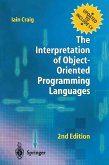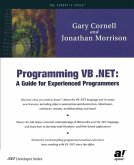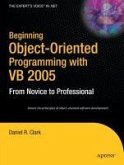Steven Roman
Concepts of Object-Oriented Programming with Visual Basic (eBook, PDF)
62,95 €
62,95 €
inkl. MwSt.
Sofort per Download lieferbar

31 °P sammeln
62,95 €
Als Download kaufen

62,95 €
inkl. MwSt.
Sofort per Download lieferbar

31 °P sammeln
Jetzt verschenken
Alle Infos zum eBook verschenken
62,95 €
inkl. MwSt.
Sofort per Download lieferbar
Alle Infos zum eBook verschenken

31 °P sammeln
Steven Roman
Concepts of Object-Oriented Programming with Visual Basic (eBook, PDF)
- Format: PDF
- Merkliste
- Auf die Merkliste
- Bewerten Bewerten
- Teilen
- Produkt teilen
- Produkterinnerung
- Produkterinnerung

Bitte loggen Sie sich zunächst in Ihr Kundenkonto ein oder registrieren Sie sich bei
bücher.de, um das eBook-Abo tolino select nutzen zu können.
Hier können Sie sich einloggen
Hier können Sie sich einloggen
Sie sind bereits eingeloggt. Klicken Sie auf 2. tolino select Abo, um fortzufahren.

Bitte loggen Sie sich zunächst in Ihr Kundenkonto ein oder registrieren Sie sich bei bücher.de, um das eBook-Abo tolino select nutzen zu können.
This book is about object-oriented programming and how it is implemented in Microsoft Visual Basic. The author presupposes a basic exposure to Visual Basic, but provides a thorough first introduction to object-oriented programming. As a result, students and programmers working with Visual Basic will find much of interest in this book.
- Geräte: PC
- ohne Kopierschutz
- eBook Hilfe
- Größe: 15.15MB
Andere Kunden interessierten sich auch für
![The Interpretation of Object-Oriented Programming Languages (eBook, PDF) The Interpretation of Object-Oriented Programming Languages (eBook, PDF)]() Iain CraigThe Interpretation of Object-Oriented Programming Languages (eBook, PDF)40,95 €
Iain CraigThe Interpretation of Object-Oriented Programming Languages (eBook, PDF)40,95 €![Testing Object-Oriented Software (eBook, PDF) Testing Object-Oriented Software (eBook, PDF)]() Imran BashirTesting Object-Oriented Software (eBook, PDF)40,95 €
Imran BashirTesting Object-Oriented Software (eBook, PDF)40,95 €![Technology of Object-Oriented Languages, Systems and Architectures (eBook, PDF) Technology of Object-Oriented Languages, Systems and Architectures (eBook, PDF)]() Technology of Object-Oriented Languages, Systems and Architectures (eBook, PDF)72,95 €
Technology of Object-Oriented Languages, Systems and Architectures (eBook, PDF)72,95 €![Programming VB .NET (eBook, PDF) Programming VB .NET (eBook, PDF)]() Jonathan MorrisonProgramming VB .NET (eBook, PDF)28,95 €
Jonathan MorrisonProgramming VB .NET (eBook, PDF)28,95 €![Beginning Object-Oriented Programming with VB 2005 (eBook, PDF) Beginning Object-Oriented Programming with VB 2005 (eBook, PDF)]() Dan ClarkBeginning Object-Oriented Programming with VB 2005 (eBook, PDF)30,95 €
Dan ClarkBeginning Object-Oriented Programming with VB 2005 (eBook, PDF)30,95 €![Essential Java 2 fast (eBook, PDF) Essential Java 2 fast (eBook, PDF)]() John CowellEssential Java 2 fast (eBook, PDF)40,95 €
John CowellEssential Java 2 fast (eBook, PDF)40,95 €![Visual Basic 2005 Recipes (eBook, PDF) Visual Basic 2005 Recipes (eBook, PDF)]() Rakesh RajanVisual Basic 2005 Recipes (eBook, PDF)34,95 €
Rakesh RajanVisual Basic 2005 Recipes (eBook, PDF)34,95 €-
-
-
This book is about object-oriented programming and how it is implemented in Microsoft Visual Basic. The author presupposes a basic exposure to Visual Basic, but provides a thorough first introduction to object-oriented programming. As a result, students and programmers working with Visual Basic will find much of interest in this book.
Dieser Download kann aus rechtlichen Gründen nur mit Rechnungsadresse in A, B, BG, CY, CZ, D, DK, EW, E, FIN, F, GR, HR, H, IRL, I, LT, L, LR, M, NL, PL, P, R, S, SLO, SK ausgeliefert werden.
Produktdetails
- Produktdetails
- Verlag: Springer US
- Seitenzahl: 188
- Erscheinungstermin: 6. Dezember 2012
- Englisch
- ISBN-13: 9781461222804
- Artikelnr.: 44172199
- Verlag: Springer US
- Seitenzahl: 188
- Erscheinungstermin: 6. Dezember 2012
- Englisch
- ISBN-13: 9781461222804
- Artikelnr.: 44172199
- Herstellerkennzeichnung Die Herstellerinformationen sind derzeit nicht verfügbar.
1 The Basics of Object-Oriented Programming.- Data Types.- Encapsulation.- Abstract Data Types.- Classes.- Defining a Class in Visual Basic.- Defining a Property in Visual Basic.- Defining a Method in Visual Basic.- Exposing Properties Through the Property Let/ Set/ Get Procedures.- Objects.- Explicit Object Creation.- Instance Variables and Member Variables.- The As Object Syntax.- Implicit Object Creation.- Referencing Public Variables and Procedures.- The Object/Message Model.- The Me Keyword.- Object Properties and Object Hierarchies.- Creating and Destroying Objects.- Creating Objects.- Destroying Objects.- Reference Counts.- Circular References.- The Notorious End Statement.- How to Control a Circular Reference-A Linked List Example.- Form Modules.- Properties and Methods in a Form Module.- Collection Classes.- Constructing a Collection Class.- Polymorphism and Overloading.- Overloading.- Polymorphism.- Inheritance.- 2 Handling Object Errors.- Error Detection and Error Handling.- Types of Errors.- The Error Object.- Dealing with Run-Time Errors.- Where to Handle a Run-Time Error.- Dealing with Logical Errors.- Detecting Logical Errors.- Where to Handle a Logical Error.- Handling the Error in the Calling Procedure.- Errors Occurring in Events.- An Error-Handling Example.- 3 Turing Machines - A Simple Object-Oriented Application.- What Is an Algorithm?.- What Is a Turing Machine?.- Informal Definition of a Turing Machine.- Describing a Turing Machine.- Coding a Turing Machine.- Error Handling.- The Symbol Class.- The Symbols Collection Class.- The State Class.- The States Collection Class.- The Transition Class.- The Transitions Collection Class.- The Machine Class.- The User Interface.- The Standard Module.- A Final Comment.- 4 OLE Automation Objects.- What IsOLE Automation?.- Public Really Means Public.- The Plan for This Chapter.- Communication Between OLE Automation Clients and Servers.- The Communication Problem.- Supplying Information to the Client.- What Is an Interface?.- The Vtable Interface.- Type Libraries.- OLE Interfaces.- The IUnknown Interface.- The IDispatch Interface.- Binding.- Putting It All Together.- In-Process and Out-of Process Servers.- Creating a Simple OLE Automation Server.- Creating a Simple Server.- A Small Client and the Three Forms of Binding.- Referencing the Server's Type Library.- Registering and Unregistering a Server.- How Servers Are Started and Ended.- Reference Counts for Servers.- Servers with a Visual Interface.- Servers with Dialog Boxes.- OLE Servers That Also Function as Stand-Alone Applications.- Handling Errors.- Be Nice.- Errors from Your Server's Servers.- Externally Creatable and Dependent Objects - The Object Hierarchy.- In-Process Issues.- Version Compatibility.- How Compatibility Can Be Affected.- How Visual Basic Handles Compatibility.- The Reference Server and Interim Builds.
1 The Basics of Object-Oriented Programming.- Data Types.- Encapsulation.- Abstract Data Types.- Classes.- Defining a Class in Visual Basic.- Defining a Property in Visual Basic.- Defining a Method in Visual Basic.- Exposing Properties Through the Property Let/ Set/ Get Procedures.- Objects.- Explicit Object Creation.- Instance Variables and Member Variables.- The As Object Syntax.- Implicit Object Creation.- Referencing Public Variables and Procedures.- The Object/Message Model.- The Me Keyword.- Object Properties and Object Hierarchies.- Creating and Destroying Objects.- Creating Objects.- Destroying Objects.- Reference Counts.- Circular References.- The Notorious End Statement.- How to Control a Circular Reference-A Linked List Example.- Form Modules.- Properties and Methods in a Form Module.- Collection Classes.- Constructing a Collection Class.- Polymorphism and Overloading.- Overloading.- Polymorphism.- Inheritance.- 2 Handling Object Errors.- Error Detection and Error Handling.- Types of Errors.- The Error Object.- Dealing with Run-Time Errors.- Where to Handle a Run-Time Error.- Dealing with Logical Errors.- Detecting Logical Errors.- Where to Handle a Logical Error.- Handling the Error in the Calling Procedure.- Errors Occurring in Events.- An Error-Handling Example.- 3 Turing Machines - A Simple Object-Oriented Application.- What Is an Algorithm?.- What Is a Turing Machine?.- Informal Definition of a Turing Machine.- Describing a Turing Machine.- Coding a Turing Machine.- Error Handling.- The Symbol Class.- The Symbols Collection Class.- The State Class.- The States Collection Class.- The Transition Class.- The Transitions Collection Class.- The Machine Class.- The User Interface.- The Standard Module.- A Final Comment.- 4 OLE Automation Objects.- What IsOLE Automation?.- Public Really Means Public.- The Plan for This Chapter.- Communication Between OLE Automation Clients and Servers.- The Communication Problem.- Supplying Information to the Client.- What Is an Interface?.- The Vtable Interface.- Type Libraries.- OLE Interfaces.- The IUnknown Interface.- The IDispatch Interface.- Binding.- Putting It All Together.- In-Process and Out-of Process Servers.- Creating a Simple OLE Automation Server.- Creating a Simple Server.- A Small Client and the Three Forms of Binding.- Referencing the Server's Type Library.- Registering and Unregistering a Server.- How Servers Are Started and Ended.- Reference Counts for Servers.- Servers with a Visual Interface.- Servers with Dialog Boxes.- OLE Servers That Also Function as Stand-Alone Applications.- Handling Errors.- Be Nice.- Errors from Your Server's Servers.- Externally Creatable and Dependent Objects - The Object Hierarchy.- In-Process Issues.- Version Compatibility.- How Compatibility Can Be Affected.- How Visual Basic Handles Compatibility.- The Reference Server and Interim Builds.







